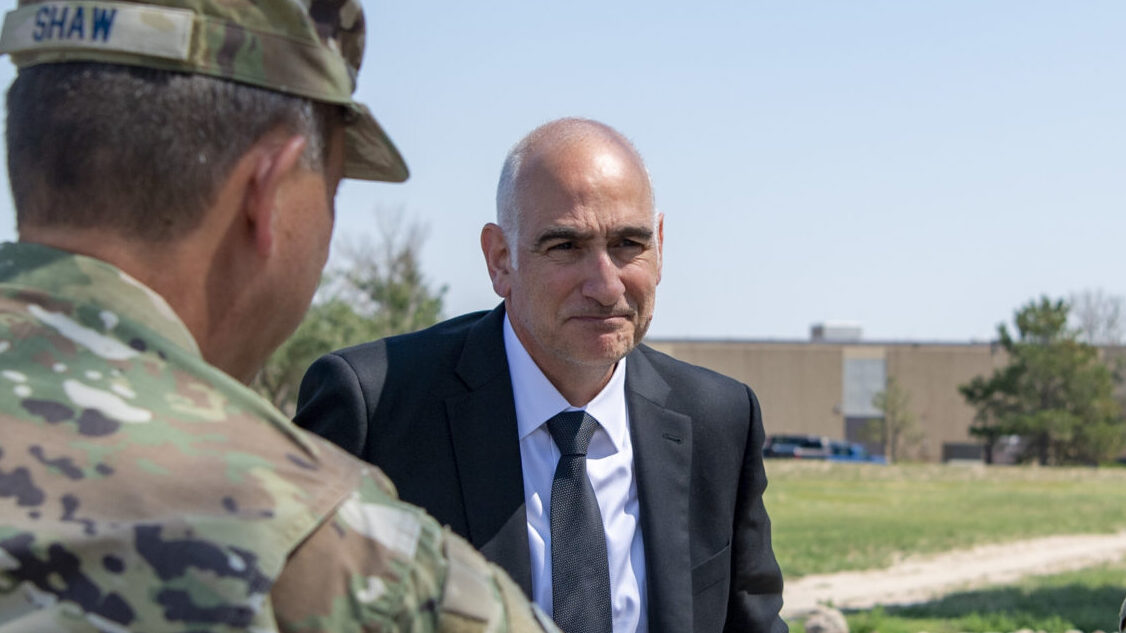
Frank Calvelli, assistant secretary of the Air Force for space acquisitions and integration. (US Space Force photo by Tiana Williams)
WASHINGTON — Frank Calvelli, head of space acquisition for the Department of the Air Force, said today that his shop is working to create a new strategy for rapidly replacing space systems lost in battle, starting with a decision about which missions to prioritize.
“It’s something that’s on our to-do list. I think the key thing that we need to work on is what mission area do we want the ability to reconstitute? You know, is it is it a communications mission area? Is it a missile warning/missile tracking mission area? Is it the space domain awareness area? Is it all the above?” he asked at GovConWire’s 2023 Space Acquisition Forum. “So we’re doing some work right now to try to figure out if we had to reconstitute stuff, what would be the priority mission areas that we would need and want to reconstitute? We haven’t gotten that far yet.”
The capability for rapid reconstitution is a key part of building resilience into the Defense Department’s space architecture, Calvelli explained.
“[R]esiliency means our systems can be counted on during times of crisis and conflict,” he said. “The four things that we need [are] proliferation, diversified orbits, integrating commercial capabilities and then the ability to reconstitute. That is how I would define resiliency.”
Building resiliency across the nation’s space ecosystem is a key focus of the Biden administration’s 2021 “United States Space Priorities Framework,” and has become a top priority for the Space Force as it reshapes its force structure, with Air Force Secretary Frank Kendall making a “resilient and effective space order of battle” his top “operational imperative.”
Congress, too, is keeping a beady eye on the service’s resiliency plan, with the 2023 National Defense Authorization Act demanding that the Space Force provide an unclassified report on how it intends to protect and defend US space assets.
“Right now the lay of the land is really focused on resilience. How do we think about operating through a contested environment and being able to perform in the in the face of a challenging threat or an evolving threat?” Gordon Kordyak, deputy director for capability delivery in Calvelli’s shop, told the GovConWire forum.
Kordyak noted that he will be moving to head up a new program executive office (PEO) for resilience being set up under Brig. Gen. Luke Cropsey, program executive officer for Command, Control, Communications, and Battle Management (C3BM) in the Air Force office of Acquisition, Technology, and Logistics led by Andrew Hunter. Hunter is essentially Calvelli’s peer in charge of acquiring Air Force rather than Space Force capabilities, and both men report directly to Kendall.
In particular, Crospey is in charge of implementing the Air Force’s Advanced Battle Management System (ABMS) designed to feed into DoD’s high-priority Joint All Domain Command and Control (JADC2) network. ABMS and JADC2 both will rely heavily on communications and intelligence, surveillance and reconnaissance capabilities provided via satellite, as well those provided by aircraft.
OP ED: To ensure JADC2, and to win in future conflicts, look to the transport layer in space
“I’ll be his deputy, and that shift’s going to happen in a couple weeks time here,” he said. “That office and its stand up is actually very emblematic of the focus that we have on resiliency and on integration, and on delivering on commitments and expectations.”
Kordyak said that the new office will be “supported by an architecture and systems engineering organization led by Dr. Bryan Tipton,” who is the chief of architecture and engineering under Cropsey.
“It’s a very strong technical focus, complemented with a program management team led by Gen. Cropsy. And holistically, that group is looking across the breadth of the [Department of the Air Force]: How can we deliver command and control capabilities effectively, how can you drive the integration of solutions … to present command and control, battle management functions effectively for JADC2?” he added.
Kordyak explained that rather than making up “the icing on the cake that is trying to hold all the pieces together,” resiliency and integration are “fundamental ingredients” to enabling JADC2.
Calvelli stressed that part of the effort to transform the military space architecture to a network of networks more likely to withstand adversary attack is moving at speed to get new systems into orbit and new capabilities into the hands of operators on the ground. To this end, he said that he is pushing the space acquisition corps to focus on using currently available technologies to develop systems within a three-year cycle — echoing the iterative approach to deploying satellites being used by the Space Development Agency.
“In order to reshape the architecture as fast as possible, I believe we need to drive satellite acquisition contracts to take less than three years from contract start to launch. I think that’s really critical,” Calvelli said.








